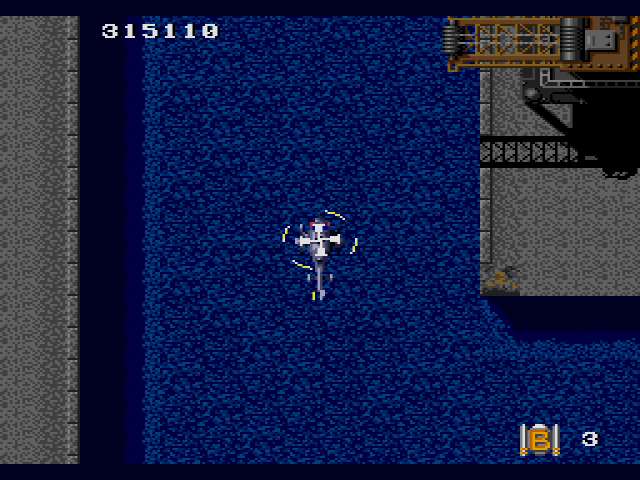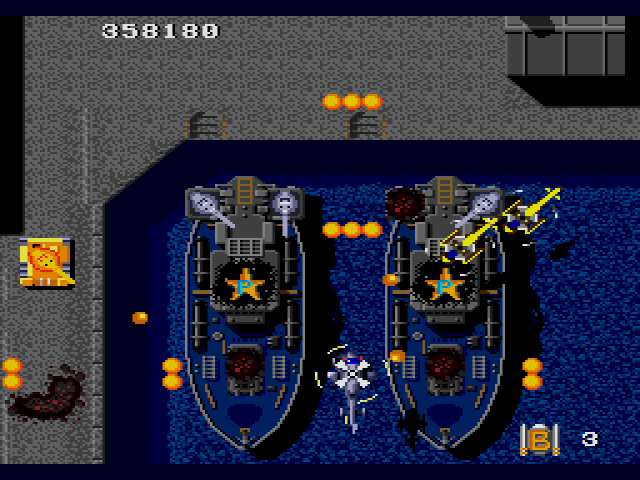

PUBLISHER: Sega (JP), Treco (US)
DEVELOPER: Toaplan (port by GRC)
RELEASE DATE: 02/22/91 (JP), 06/1991 (US)
ALSO ON: Arcade, FM Towns, iOS, NES, Sharp X68000, TurboGrafx-16
On the surface, Twin Cobra is Yet Another Shoot-em-up. You control a helicopter, enemies come towards you, you destroy them, and so on. Right away, however, you notice the helicopter feels different. It’s much smoother and faster than your standard shmup spaceship or plane. Quicker motion allows you to sweep across the screen and take out more enemies at once. When your weapon hits its target, the resulting explosion yields a satisfying crunch noise that makes you want to shoot more. Propulsive background music spurs you forward, even when you take the inevitable hit and have to start over.

The aforementioned subtleties and nuances might seem like nothing, but they’re important in the shoot-em-up genre. Without them, shumps tend to blend together since so many of them share the same characteristics and features. I’ve lamented many, many times over the years on this site about the absolute barrage of shoot-em-ups the Genesis received in its first couple years. Rightfully so, as while there are some true standout classics like M.U.S.H.A. or Thunder Force III, the majority of the shmups are mediocre at best and downright awful at worst.

Toaplan, however, always produced something of worth, even when their shmups weren’t the most innovative or creative. Truxton asked the question “What if a heavy metal album was also a shoot-em-up?” and the answer was constant aggression and over-the-top imagery. Hellfire is a little less insane (although no less difficult), but its unique four-way directional weapon surprisingly breathed new life into the genre for me.
Twin Cobra sits alongside Toaplan’s more conservative fare like Twin Hawk and Fire Shark. These three games don’t pretend to move the genre forward. Their focus is a sort of shoot-em-up purity where the player is fully engaged in the carnage and nothing else.

The ten levels featured here are generous and action-packed, but the visual aesthetics – brown military bases, yellow helicopters, and gray bombers – blur together across those ten levels. Every level begins and ends on an aircraft carrier in the middle of the ocean, which is pretty cool. But every level also shares the same basic assets, just shifted around to create a slightly different experience. The four power-ups are solid, but again, we’ve seen red bullet sprays and green laser blasts a thousand times. Visually and mechanically, there’s nothing new here.

Twin Cobra works because of its feel. Despite the lackluster visuals and basic power upgrades, the game plays beautifully. During one of my playthroughs, I experienced what I call a “transcendent” moment where I felt at one with the game. My helicopter swept back and forth across the screen, like a ballet dancer. I took down enemy helicopters and turrets left and right, avoided their fire, upgraded my weapons. Shoot-em-up fans love these moments; it reminds us of why we persist with the genre. At their best, shmups make you feel – if only for a brief moment – dangerous and invincible.

And I shouldn’t have to say it, but I will: Twin Cobra is hard. Thankfully, the game comes with a generous option menu, stacked with your choice of eight difficulty levels. Eight! The harder the difficulty, the more credits you receive, but even if you choose the easiest difficulty, you still get ten credits. Twin Cobra is hard.
Do you like to blow crap up and feel cool doing it? Twin Cobra is for you… me… all of us who just want a little extra destruction with our day.
B


2 replies on “Twin Cobra (Genesis, 1991)”
This game is crazy hard. I don’t think I’ve ever even made it to stage 2. It feels great though – just a bit short of Flying Shark because the enemies are so aggressive.
Toaplan always means business.